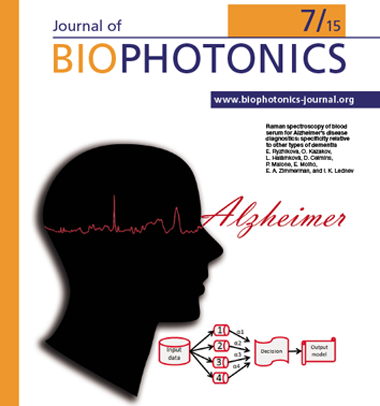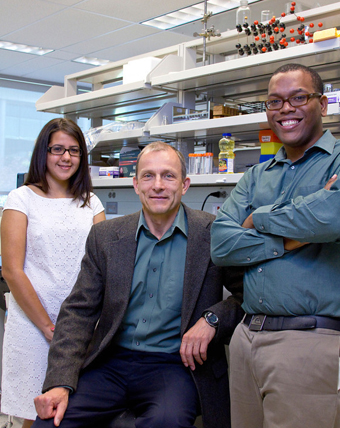UAlbany and Albany Med Study Examines New Method for Diagnosing Alzheimer's Disease
 |
|
Reporting in the July 2015 Journal of Biophotonics, UAlbany Professor Igor Lednev and colleagues at Albany Med have developed a new method for noninvasive diagnostics of Alzheimer’s Disease.
|
ALBANY, N.Y. (August 13, 2015) -- A team of scientists at the University at Albany and Albany Medical Center have developed a new method for noninvasive diagnostics of Alzheimer’s Disease (AD). Taking Raman spectra of blood samples, the research led by Igor Lednev of the University at Albany and Dr. Earl Zimmerman of Albany Medical Center, distinguished people with Alzheimer’s disease from healthy controls as well as from people with other forms of dementia.
Reporting in the Journal of Biophotonics, the team applied near infrared (NIR) Raman microspectroscopy of blood together with advanced computer analysis for the selective identification of AD. The researchers analyzed data from 20 AD patients, 18 patients with other neurodegenerative dementias (OD) and 10 healthy control (HC) subjects. NIR Raman microspectroscopy differentiated patients with more than 95 percent sensitivity and specificity.
"We demonstrated the high discriminative power of artificial neural network (ANN) classification models, thus revealing the high potential of this developed methodology for the differential diagnosis of AD," said Lednev, a professor of chemistry at UAlbany. "Raman spectroscopic, blood-based tests may aid clinical assessments for the effective and accurate differential diagnosis of AD, decrease the labor, time and cost of diagnosis, and be useful for screening patient populations for AD development and progression."
 |
|
Professor Igor Lednev with doctoral students Manuel F. Rosario-Alomar and Tatiana Quinones (Photo Paul Miller)
|
With a worldwide estimate for patients suffering from Alzheimer’s Disease -- between 21 and 35 million as of 2010 -- the research is significant since it potentially offers a noninvasive method for differentiating AD from other forms of dementia. The team utilized a series of computer programs to determine which spectral features best separated people with AD from healthy controls or from people with other dementias The algorithms distinguished mild or moderate Alzheimer’s from healthy controls and people with other dementias that opens a potential opportunity for early disease diagnostics.
While the technique does not identify individual blood components that distinguish Alzheimer's from other diseases, most of the spectral "fingerprints" occurred when photons interacted with proteins, as opposed to lipids, DNA, or other molecules that may be in the blood. "We can conclude that the composition of these blood samples differs in protein makeup," said Lednev, who is also part of UAlbany's RNA Institute.
The collaboration was funded through the NY CAP Research Alliance. The next step, according to Lednev, is to validate the test with a larger number of patients, and look for the effects of additional factors, such as patient medication, and other illnesses.
![]() For more news, subscribe to UAlbany's RSS headline feeds
For more news, subscribe to UAlbany's RSS headline feeds
A comprehensive public research university, the University at Albany-SUNY offers more than 120 undergraduate majors and minors and 125 master's, doctoral and graduate certificate programs. UAlbany is a leader among all New York State colleges and universities in such diverse fields as atmospheric and environmental sciences, business, education, public health,health sciences, criminal justice, emergency preparedness, engineering and applied sciences, informatics, public administration, social welfare and sociology, taught by an extensive roster of faculty experts. It also offers expanded academic and research opportunities for students through an affiliation with Albany Law School. With a curriculum enhanced by 600 study-abroad opportunities, UAlbany launches great careers.


